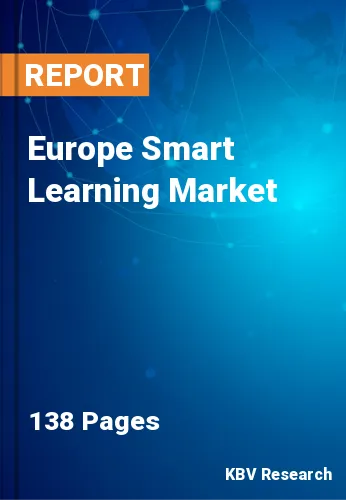The Europe Smart Learning Market would witness market growth of 19.6% CAGR during the forecast period (2022-2028).
Visual learning, which incorporates smart technology features such as graphs, graphics, charts, and presentations, is thought to be particularly successful in helping pupils absorb concepts more quickly. The kids are able to retain more information since they are able to learn properly. Smart teaching programs reduce the material in an easy-to-understand format, allowing students to grasp and recall knowledge and information for extended periods of time. From the computer monitor to the smartboard, teachers can utilize these devices to help students learn a topic in a simple way by using images and text that is written in a manner that is easily understandable.
For example, to teach students subtraction and addition, these devices use pictures of fruits and vegetables combined with a voice-over that can be easily registered in the minds of small children. In addition, smart learning makes extensive use of visual allusions and colors, which aids in gaining more engagement of students in the subject. It also serves as a motivator for students to develop their creative imagination. For example, if smart learning demonstrates how a seed grows into a plant, it may aid a student's creativity in drawing a plant and all of its intricacies.
The high disposable income of the people is a major factor that is playing a significant role in the rising adoption of the latest technologies all over the region. Due to the increased spending of people on the education of their children, various schools and other educational facilities are substantially emphasizing on the advancement of the latest and advanced learning tools and methods. Due to this, the deployment of various smart learning tools, such as smartboards, is constantly increasing in the regional educational institutes. Moreover, the demand for this approach is also increasing in the large enterprise sector of the region. There is a considerable number of large enterprises in the region. Owing to the rising prevalence of major market players, the demand for smart learning paradigms from these enterprises is being seamlessly fulfilled.
The Germany market dominated the Europe Smart Learning Market by Country in 2021, and would continue to be a dominant market till 2028; thereby, achieving a market value of $8,332.4 million by 2028. The UK market is poised to grow at a CAGR of 18.6% during (2022 - 2028). Additionally, The France market would witness a CAGR of 20.4% during (2022 - 2028).
Based on Component, the market is segmented into Hardware, Software (Standalone and Integrated), and Services. Based on Hardware Type, the market is segmented into Interactive displays, Interactive whiteboards, Smartboards, and Others. Based on Standalone Type, the market is segmented into LMS/LCMS, Student Information System, Classroom Management Software, Language Learning Software, and Others. Based on Learning Type, the market is segmented into Asynchronous Learning and Synchronous Learning. Based on End User, the market is segmented into Academic, Enterprises, and Government. Based on countries, the market is segmented into Germany, UK, France, Russia, Spain, Italy, and Rest of Europe.
Free Valuable Insights: The Global Smart Learning Market Size will Hit $128.4 Billion by 2028, at a CAGR of 20.3%
The market research report covers the analysis of key stake holders of the market. Key companies profiled in the report include Pearson PLC, IBM Corporation, Oracle Corporation, SAP SE, Google LLC, Microsoft Corporation, Cisco Systems, Inc., Adobe, Inc., Qisda Corporation (BenQ), and Samsung Electronics Co., Ltd. (Samsung Group)
By Component
By Learning Type
By End User
By Country
Our team of dedicated experts can provide you with attractive expansion opportunities for your business.

